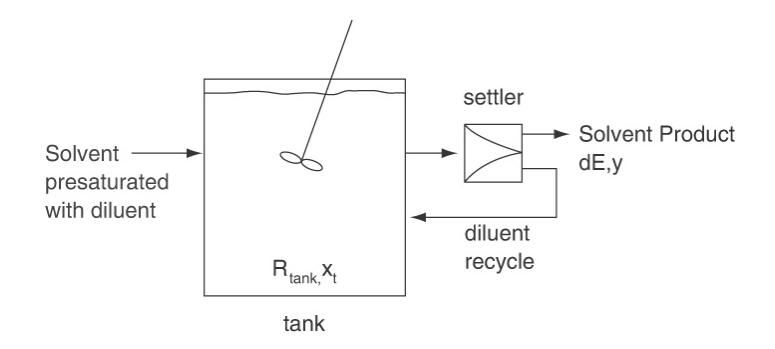Solve Problem 14.E2, part b, but do not assume (R_{t}) is constant. Derive an alternative for Eq.
Question:
Solve Problem 14.E2, part b, but do not assume \(R_{t}\) is constant. Derive an alternative for Eq. (13-29a) for nonconstant \(\mathrm{R}_{t}\) but with a constant amount of insoluble solids. Then integrate numerically (e.g., with Simpson's rule).
Problem 14.E2
Your company continues to have the stinky job of processing halibut livers detailed in Problem 14.E1. Halibut arrive in batches on the fishing boats, so you decide to evaluate a continuous solvent addition batch operation. The system is similar to the extraction system shown in Figure 13-12, except a filter is used instead of a settler. Derivation of Eqs. (13-28a) to (13-29a) is valid, but because equilibrium is not linear, Eq. (13-29b) is not valid. The feed is the same \(25.2 \mathrm{wt} \%\) fish oil, \(74.8 \mathrm{wt} \%\) insoluble solids feed as in Problem 14.E1. \(1000.0 \mathrm{~kg}\) of this feed are to be processed using pure diethyl ether as solvent. Operation proceeds by first adding enough solvent so that the mixture is in a two-phase region. Then pure oil is skimmed off at the same rate as the solvent is added.
a. How much solvent must be added so that the mixture is in a two-phase region? The two-phase region starts when the mixing line crosses the saturated curve. Because there can be no removal of extract until this amount of solvent is added, Eq. (13-29a) is not valid until this amount of solvent is added.
b. Continuous solvent addition batch operation continues adding solvent until the weight fraction of oil in raffinate remaining in the tank is 0.02 . Determine the total \(\mathrm{kg}\) of solvent required, the weight of the raffinate remaining in tank, and the concentration of the raffinate. Also find the weight of the extract collected and the average weight fraction of the oil and the solvent in the extract. Note: Because Eq. (13-29a) assumes that \(R_{t}\) is constant, approximate constant \(R_{t}\) by using the average value of \(R_{t}\) in Eq. (13-29a) over the period when the extract is removed.
Figure 13-12

Data From E1
You are processing halibut livers that contain approximately \(25.2 \mathrm{wt} \%\) fish oil and \(74.8 \mathrm{wt} \%\) insoluble solids. The following data for leaching fish oil from halibut livers using diethyl ether solvent are given by Brown et al. \((1950)\) :

where \(\mathrm{y}_{\mathrm{oil}}\) is the mass fraction oil in the overflow, which was found to contain no insoluble solids, and \(\mathrm{Z}\) is the pounds of solution per pound of oil-free solids in the underflow.
a. Convert the data to the mass fraction of oil and solvent in the overflow and to mass fraction of oil, solvent, and solids in the underflow. Plot saturated extract and raffinate curves with tie lines on a graph with \(\mathrm{y}_{\text {oil }}\) or \(\mathrm{x}_{\text {oil }}\) as the ordinate and \(\mathrm{y}_{\text {solids }}\) or \(\mathrm{x}_{\text {solids }}\) as the abscissa. Develop the conjugate line.
b. \(1000.0 \mathrm{lb}\) of fish (oil + solids) is mixed with \(500.0 \mathrm{lb}\) of pure diethyl ether. The mixture settles and the solvent layer is drawn off. Calculate the weight fraction of oil in the extract and raffinate layers and the amounts of extract and raffinate.
c. The raffinate from step \(\mathrm{b}\) is now mixed with \(500.0 \mathrm{lb}\) of pure diethyl ether. After settling, calculate the weight fraction of oil in the extract and raffinate layers and the amounts of extract and raffinate.
d. We have a total of \(1000.0 \mathrm{lb}\) of fish (oil + solids)/h. We continuously mix the fish with \(500.0 \mathrm{lb}\) of pure diethyl ether \(/ \mathrm{h}\) in a thickener and draw off the solvent layer. Calculate the weight fraction of oil in the extract and raffinate layers and the flow rates of extract and raffinate.
e. The raffinate from step \(\mathrm{d}\) is now mixed with \(500.0 \mathrm{lb} / \mathrm{h}\) of pure diethyl ether in a second thickener. Calculate the weight fraction of oil in the extract and raffinate layers and the flow rates of extract and raffinate.
f. \(1000.0 \mathrm{lb}\) of fish (oil + solids)/h are continuously processed in a countercurrent cascade of thickeners. Use \(500.0 \mathrm{lb} / \mathrm{h}\) of pure diethyl ether. We want the outlet raffinate to contain \(2.0 \mathrm{wt} \%\) fish oil. Find the number of stages required.
Equation (13-28a)

Equation (13-29a)

Equation (13-29b)

Step by Step Answer:

Separation Process Engineering Includes Mass Transfer Analysis
ISBN: 9780137468041
5th Edition
Authors: Phillip Wankat




